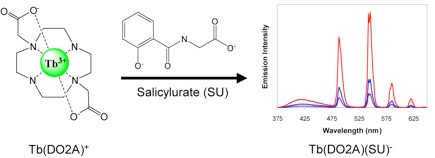Receptor Site Design to Target Specific Analytes


We are interested in the construction of highly specific receptor sites to bind target analytes, for the purpose of detection using luminescence spectroscopy or microscopy. By tailoring the size, shape and substituents bound to the macrocyclic ligand, lanthanide-macrocycle complexes can be designed to select for a target aromatic anion, even in the presence of interfering species. We have found much success with a terbium macrocycle complex in detecting dipicolinate, a unique chemical marker for bacterial spores; we now expand this sensor design strategy to other aromatic anions of interest. Specifically, we are exploring salicylates, catecholamines, microbial metabolites and their derivatives.
Salicylurate (SU), the major metabolite of acetylsalicylic acid (aspirin), can be detected readily in urine using the Tb(DO2A) binary complex. Detection of SU in the body is important to help monitor aspirin pharmacokinetics, and SU levels can also function as an indicator of appendicitis, anemia, liver disease and other conditions. Current detection methods require either solvent extraction or other sample handling prior to analysis. Binding of SU to form the Tb(DO2A)(SU) ternary complex triggers intense luminescence under UV excitation with a total preparation and analysis time of under five minutes. Though this work represents only a proof-of-principle in terms of SU receptor site design, this system has already achieved a limit of detection of around 1.8 mg/L, within the range of the most competitive techniques available.

publications
Terbium-macrocycle complexes as chemical sensors: Detection of an aspirin metabolite in urine using a salicylurate-specific receptor site. Esplin, T.L.; Cable, M.L.; Gray, H.B.; Ponce, A. Inorganic Chemistry, 2010, 49 (10), 4643-4647. [PDF]
